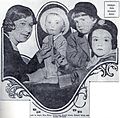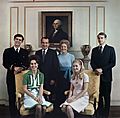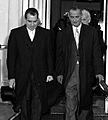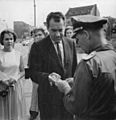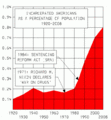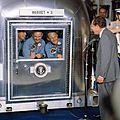Richard Nixon facts for kids
Quick facts for kids
Richard Milhous Nixon
|
|
|---|---|
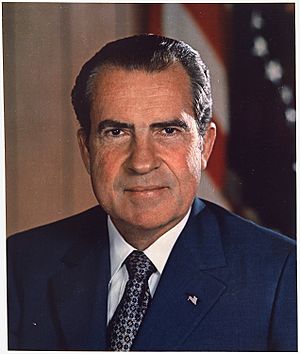 |
|
| 37th President of the United States | |
| In office January 20, 1969 – August 9, 1974 |
|
| Vice President | Spiro Agnew (1969–1973) Gerald Ford (1973–1974) |
| Preceded by | Lyndon B. Johnson |
| Succeeded by | Gerald Ford |
| 36th Vice President of the United States | |
| In office January 20, 1953 – January 20, 1961 |
|
| President | Dwight D. Eisenhower |
| Preceded by | Alben W. Barkley |
| Succeeded by | Lyndon B. Johnson |
| United States Senator from California |
|
| In office December 4, 1950 – January 1, 1953 |
|
| Preceded by | Sheridan Downey |
| Succeeded by | Thomas Kuchel |
| Member of the U.S. House of Representatives from California's 12th district |
|
| In office January 3, 1947 – December 1, 1950 |
|
| Preceded by | Jerry Voorhis |
| Succeeded by | Patrick Hillings |
| Personal details | |
| Born | January 9, 1913 Yorba Linda, California, U.S. |
| Died | April 22, 1994 (aged 81) New York City, New York, U.S. |
| Nationality | American |
| Political party | Republican |
| Spouse | Pat Nixon |
Richard Milhous Nixon (born January 9, 1913 – died April 22, 1994) was the 37th President of the United States. He served as president from 1969 to 1974. He is the only U.S. president who has ever resigned (quit) from office.
Before becoming president, Nixon was a Republican politician from California. He served as a U.S. Representative and a U.S. Senator. He was also the 36th Vice President of the United States. He served as Vice President from 1953 to 1961 under President Dwight Eisenhower.
Nixon's time as president is remembered for several important events. These include improving relations with China and slowly ending the Vietnam War. He also created new government agencies like OSHA and the Environmental Protection Agency. His presidency also saw a time of peace with the Soviet Union. However, he is also known for the Watergate scandal. This scandal caused the public to lose trust in him and led to his resignation.
Contents
Early Life and Education
Richard Nixon was born in 1913 in his family's home. This was in Yorba Linda, California. He grew up as a Quaker. Only one other U.S. president, Herbert Hoover, was a Quaker.
Nixon spent his childhood in Whittier, California. His father had Scotch-Irish roots. His mother had German, English, and Irish family. He went to Whittier High School and then Whittier College. Later, he studied law at Duke University. During World War II, he served in the Navy. He later married and had two daughters.
Starting His Political Career
Nixon began his political journey in 1946. He was elected to the House of Representatives.
Serving in the House of Representatives
While in the House, Nixon was part of the House Un-American Activities Commission. This group worked to find people in the United States who might have been Communists.
Becoming a Senator
In 1950, Nixon was elected as a Senator. He won after a difficult campaign against Helen Gahagan Douglas.
Becoming Vice President
In the 1952 presidential election, Dwight D. Eisenhower chose Nixon as his running mate for vice president. Some people accused Nixon of getting illegal money for his campaign. They wanted Eisenhower to pick someone else. But Eisenhower kept Nixon on the ticket.
Nixon gave a famous speech to explain himself. He said that no matter what people accused him of, he would keep one campaign gift: his dog named Checkers. The Republican Party decided to keep Nixon as their vice-presidential candidate. Eisenhower won the election, and Nixon became Vice President from 1953 to 1961.
Busy Years as Vice President
As Vice President, Nixon was very active. He traveled around the world, including to South America. He also visited the Soviet Union. There, he had a famous "Kitchen Debate" with the Soviet leader Nikita Khrushchev. They argued about which country was better.
Running for President
In the 1960 presidential election, Nixon ran against Democrat John F. Kennedy. Kennedy was expected to win after their first televised debate. But Nixon gained ground as Election Day got closer. Kennedy won, but it was a very close election.
In 1962, Nixon lost the election for governor of California. He lost to Pat Brown. After this loss, Nixon famously said, "You won't have Dick Nixon to kick around anymore." Many thought his political career was over.
However, in 1968, Richard Nixon ran for president again. He defeated Hubert Humphrey and became president in 1969.
Nixon's Presidency
Nixon took office during the Vietnam War. He continued the war but with a new plan. His strategy was to slowly remove U.S. troops. This would allow South Vietnamese troops to take over the fighting.
Vietnam War and Protests
Nixon secretly bombed enemy targets in Cambodia and North Vietnam. This was meant to help South Vietnam win. When the bombing spread to Cambodia and Laos in 1970, it caused huge protests in America. Protests happened at Kent State and in Washington, DC. More than 12,000 people were arrested in May 1971. Because of this strong opposition, Nixon sped up troop withdrawal. He also ended the military draft.
Foreign Policy Successes
Nixon was very successful in foreign policy. This means how a country deals with other countries. He started a policy called "detente." This helped reduce tensions between the United States and the Soviet Union. The two countries began to get along better. They signed treaties to limit nuclear weapons.
Nixon also made a historic trip to communist China. He built a very good relationship with them. Before this, the U.S. and China had almost no contact. This opened the door for many years of trade between the two countries. Many items in the United States are now made in China because of this. His diplomacy with China is seen as one of his greatest achievements.
Domestic Reforms
At home, Nixon signed many new laws. He created the Environmental Protection Agency (EPA). This agency works to protect the environment. He also supported laws against drugs and crime. He also backed laws against discrimination. When inflation (when money loses value and prices go up) was high, he froze prices for 90 days.
Even though he was known as a conservative Republican, he supported some liberal ideas. These were often supported by Democrats. In 1974, Nixon even spoke about a plan for universal health care.
The Watergate Scandal and Resignation
Nixon won re-election by a huge margin in 1972. Most Americans approved of him then. But soon after, his reputation was damaged. Most Americans began to disapprove of him. This was due to a scandal called "Watergate."
During this scandal, men broke into the Democratic National Headquarters. Nixon tried to cover up the break-in. He may have even ordered it. Because of this, Congress was going to put him on trial. This process is called impeachment, and it can remove a president from power.
Nixon tried to hide taped conversations that showed his involvement. But the Supreme Court ordered him to hand them over. To avoid being removed from office, Nixon resigned (quit) the presidency in 1974.
After the Presidency
Nixon's second vice president, Gerald Ford, became president. Ford gave Nixon a pardon. This meant Nixon would not be punished for any crimes related to Watergate. Ford wanted to end the crisis quickly. He felt the nation faced more important problems. Many people blamed Ford for letting Nixon go unpunished. This led them to vote against Ford in the 1976 election.
Nixon's public image never fully recovered. However, he continued to advise later presidents. He also worked with other government officials and the media. His books about his life were considered important reading. His work in opening relations with China was praised.
Nixon died in 1994 from a stroke. This was ten months after his wife, Pat, passed away. The house where he was born is now part of the Richard M. Nixon Presidential Library and Museum. He was buried at the library.
Images for kids
-
Nixon's family: Julie and David Eisenhower, President Nixon, First Lady Pat Nixon, Tricia and Edward Cox (December 24, 1971)
-
Nikita Khrushchev and Nixon speak at the Kitchen Debate, July 24, 1959
-
John F. Kennedy and Nixon before their first televised debate in 1960
-
Nixon and Lyndon Johnson leaving the White House for the Kennedy–Johnson inauguration
-
Nixon is sworn in as the 37th President by Chief Justice Earl Warren. Pat Nixon holds the family Bible.
-
Mao Zedong and Nixon -
Nixon with Mexican president Gustavo Díaz Ordaz in San Diego, California, September 1970
-
Nixon with Israeli Prime Minister Golda Meir, June 1974.
-
Nixon with President Anwar Sadat of Egypt, June 1974
-
Nixon at the Washington Senators' 1969 Opening Day.
-
Nixon visiting the Apollo 11 astronauts after their moon mission.
-
President Ronald Reagan meets with former presidents Gerald Ford, Jimmy Carter and Nixon, October 1981.
-
Nixon with President Bill Clinton at the White House, March 1993
-
Five U.S. presidents (including President Bill Clinton) and their wives at Richard Nixon's funeral, April 27, 1994.
-
With Elvis Presley in December 1970.
-
Presidents Gerald Ford, Nixon, George H. W. Bush, Ronald Reagan, and Jimmy Carter in 1991
See also
 In Spanish: Richard Nixon para niños
In Spanish: Richard Nixon para niños


